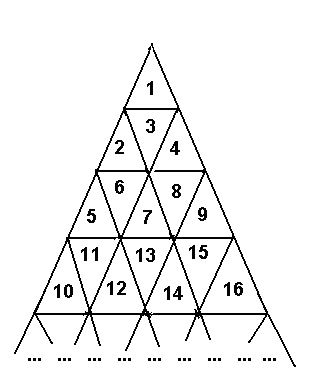Delta-wave
Time Limit: 2000/1000 MS (Java/Others) Memory Limit: 65536/32768 K (Java/Others) Total Submission(s): 4768 Accepted Submission(s): 1811
Problem Description
A triangle field is numbered with successive integers in the way shown on the picture below.
Write the program to determine the length of the shortest route connecting cells with numbers N and M.

Write the program to determine the length of the shortest route connecting cells with numbers N and M.
Input
Input contains two integer numbers M and N in the range from 1 to 1000000000 separated with space(s).
Output
Output should contain the length of the shortest route.
Sample Input
6 12
Sample Output
3
Source
#include <iostream> #include <cmath> using namespace std; struct Node{ int n; //数字 int a; //同层时从左到右的序数 int h; //深度 Node ( int num ): n(num) { h = (int) sqrt( (double) n-1 ) + 1; a = num-(h-1)*(h-1); } Node (){} }; int dfs ( Node& x , Node& y , int d ){ // d 指的是距离 if ( x.h == y.h ) return d+=abs ( x.n-y.n ); else if ( x.a&1 ) // 序数为奇数的x在下三角 { x.h++; x.a++; x.n=(x.h-1)*(x.h-1)+x.a; dfs ( x , y , ++d ); } else //上三角的情况 { if ( y.a > x.a +( y.h - x.h ) ) // y如果在x的右边 { x.h++; x.a+=2; x.n=(x.h-1)*(x.h-1)+x.a; d+=2; dfs ( x,y,d); } else { x.h++; x.n=(x.h-1)*(x.h-1)+x.a; d+=2; dfs ( x,y,d); } } } int main (){ int n1,n2; while ( cin>>n1>>n2 ) { Node x( n1 ); Node y( n2 ); if ( x.n > y.n ) //只讨论y.n>=x.n的情况 { Node temp; temp = x;
x=y; y=temp; } cout<< dfs ( x , y , 0 ) <<endl; } return 0; }
#include <iostream> #include <cmath> using namespace std; int caculate_x ( int n ){ //从上到下数第x层 return (int)sqrt( (double)n-1 ) + 1; // x=(int)sqrt(n-1)+1 } int caculate_y ( int n , int x ){ //从左上到右下第y层 return n- ((x-1)*(x-1))/2 +1; //第x层最左端的数为(x-1)^2+1 , 最右端的数为x^2 } int caculate_z ( int n , int x ){ //从右上到左下第z层 return (x*x-n)/2 + 1; } int main (){ int m,n,dmin, n_x , n_y , n_z , m_x , m_y , m_z; while ( cin>>m>>n ) { m_x = caculate_x ( m ); //分别计算出n,m的x,y,z m_y = caculate_y ( m , m_x ); m_z = caculate_z ( m , m_x ); n_x = caculate_x ( n ); n_y = caculate_y ( n , n_x ); n_z = caculate_z ( n , n_x ); cout<<abs( m_z-n_z ) + abs( m_y+n_y ) + abs( m_x+n_x )<<endl; //这个至今没搞懂... } return 0; }//这个不知道怎么没过,但是这个思想是过了的//我会说这是hdu的discuss里看到的?